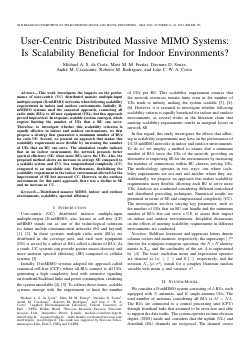
User-Centric Distributed Massive MIMO Systems: Is Scalability Beneficial for Indoor Environments?
Michael André Sousa Costa, Marx Miranda de Freitas, Daynara Dias Souza, Andre Mendes Cavalcante, Roberto Menezes Rodrigues, Joao Weyl Costa
DOI: 10.14209/sbrt.2024.1571032548
Evento: XLII Simpósio Brasileiro de Telecomunicações e Processamento de Sinais (SBrT2024)
Keywords: Distributed massive MIMO Indoor and outdoor environments Scalability Spectral efficiency
Abstract
This work investigates the impacts on the perfor- mance of user-centric (UC) distributed massive multiple-input multiple-output (D-mMIMO) networks when following scalability requirements in indoor and outdoor environments. Initially, D- mMIMO systems used the canonical approach, connecting all radio units (RUs) to all user equipment (UEs), but this approach proved impractical. In response, scalable systems emerged, which require limiting the number of UEs that a RU can serve. There- fore, to investigate whether this scalability criterion is equally effective in indoor and outdoor environments, we first propose a strategy that guarantees a minimum number of RUs for each UE. Second, we present an approach that makes this scalability requirement more flexible by increasing the number of UEs that an RU can serve. The simulation results indicate that for indoor environment the network presents better spectral efficiency (SE) when more RUs serve the UEs. Also, the proposed method shows an increase in average SE compared to a scalable system and 47% less computational complexity (CC) compared to an unscalable one. Furthermore, flexibilizing the scalability requirement in the indoor environment allowed for the improvement of SE but increased CC. However, in the outdoor environment, for this same approach, there was a decline in SE and an increase in CC.Download